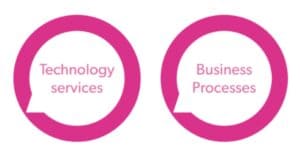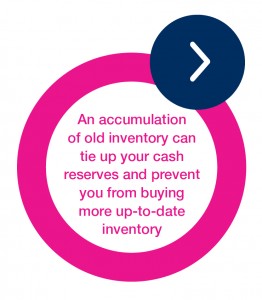Outsourcing is nearly always cheaper, more efficient, and more flexible than hiring in-house staff. You can use outsourcing to tap into expertise and experience not available in-house (technical or managerial) or to identify and then reduce the costs of support services.
But concerns about the potential pitfalls of outsourcing stop SMEs from seeing the many benefits of outsourcing (which would allow their full-time employees to work on the company’s core competencies).
A part-time CFO can help you to leverage outsourcing, allowing you to operate a leaner, more efficient business and use the savings to drive growth. In these articles, you will see:
- The benefits of outsourcing
- What can be outsourced
- How to use outsourcing in your organization
- The main reasons companies don’t outsource
- How a part-time CFO can help you to leverage outsourcing
A desire to focus on core activities is one of the main reasons companies of any size choose to outsource one or more of their support functions.
You can use outsourcing to tap into expertise and experience not available in-house (technical or managerial) or to identify and then reduce the costs of support services. But outsourcing is something that worries many SME owners. They fear that outsourcing non-core aspects of the business like finance, HR, IT or managing customer relationships will lessen their overall control of the company. Or that it will be restrictive or expensive.
You might feel that not being able to see and talk to your team will mean that you are less in control and that you lack the visibility to spot potential problems and take decisive action.
You might worry too about the track record of your chosen outsourced provider. Will they maintain the high standards you insist on and deliver quality within the deadlines you prescribe?
Or maybe you worry about costs: will the prices quoted by your provider be set in stone or as the relationship develops, will a number of hidden costs emerge (licence fees, annual renewal fees, maintenance fees, etc.)?
Perhaps the reliability of your outsourced provider concerns you. Will your provider respect your company’s confidentiality? Will your data and other assets be safe in someone else’s hands? Will your ideas be stolen or will your customers’ sensitive data be hijacked by the people you hire?
What will happen if things go wrong with your provider? Are they happy to share a detailed contingency plan with you so that you can feel assured that you will not be hung out to dry if a serious problem arises?
What level of importance does your provider attach to compliance?
How can you be sure that laws and regulations will be adhered to and that you will not be held liable for infringements?
It’s these kinds of concerns that stop business owners from seeing the many benefits of outsourcing (which would allow their full-time employees to work on the company’s core competencies).
One such owner was Simon Wakefield, Managing Director of green bean coffee importers DRWakefield. His bank was asking some pretty tough questions at the time and he knew he needed help.
“Not having enough background information, data and statistics to lay out for the banks to see what we were doing, we soon realized we needed someone who could manage those and help us make those decisions,” he says.
But at first, he was reluctant to hire an CFO on a part-time basis.
“Part-time was something I’d never have considered before because I like to have people in-house that work with us and understand our business. It sounds simple, but when you start drilling into the way we work with multiple currencies, multiple countries, it becomes quite detailed.
“In my previous experiences of part-time employees, they would come, they would be freelance, they would go and it didn’t work with us.”
He eventually overcame his reluctance to outsource and hired a part-time CFO from The CFO Centre.
“The CFO Centre offered us something: if our first CFO didn’t work out, they would quickly put in another one. If the CFO they installed didn’t have the answer to some information that we needed, he was part of a bigger pool that he could get information from and bring to us.”
Not only did his part-time CFO Nick Thompson help improve his relationship with the bank by bringing in a permanent management accountant to take care of the finances but he also helped update the company’s accounting software packages and credit control procedures, so that it had a far better cash flow than it did beforehand.
“In the five years Nick’s been here, we’ve grown about 30% in numbers. He’s helped bring in new software and changed our auditors so that we have a more professional auditor looking after us now. So there have been very clear targets and goals that have been achieved. From the other side, it’s meant that I can sleep better.”
Any functionality that is not core to your business should be outsourced at the best cost and quality, says Kevin D. Johnson, author of The Entrepreneur Mind: 100 Essential Beliefs, Characteristics and Habits of Elite Entrepreneurs.³
“In the majority of cases, trying on your own to produce everything that your business needs is unrealistic and highly inefficient,” he says. “If you have believed the negative hype about outsourcing, quickly disabuse yourself of it and implement the process into your business strategy.
“If you’re subscribing to the propaganda and refusing to even consider outsourcing, your competitors are meanwhile outsourcing and working hard to put you out of business.”
Outsourcing is nearly always cheaper, more efficient, and more flexible than hiring in-house staff. The benefits include:
- Access to expertise that you would otherwise not be able to afford
- Time savings for you and your in-house staff
- Opportunity to focus on revenue-boosting areas of your business
- Lower costs
- More predictability in costs
- Maximizing efficiencies
- Enabling a sharper focus on core competencies
- Increasing business productivity.
What can be outsourced? Outsourced services can be categorized into the following two groups:

Technology services
Companies require advanced IT and communication technologies for their regular operations. Rapid changes in the technology sector bring new capabilities to use for companies that need to select the right kind of vendor to get the best technology at the cheapest cost. The following technology services are generally outsourced:
- Software and applications
- Infrastructure
- Telecommunications
- E-commerce
- Web security and solutions
- Web hosting, website designing, development and maintenance
- Logistics, procurement and supply chain management
- Research and analysis
- Product development
- Legal services
- Intellectual property research and documentation
- Tech support
- Customer help desk functions
- On-site maintenance
- Email management
- Data centre operations
- Disaster recovery
- Security management
- Virus protection
- Data backup and recovery
- Wireless support
- Purchase consulting
- Network architecture
Business Processes Human Resources
- Payroll services (including payroll statements, bonuses, commissions, tax payments, etc.)
- Benefits administration
- Recruitment
- Training
- Expense management
- Management of travel and employee records (personnel forms, policies, procedures, performance management, etc.)
Finance
- Managing accounts payable/receivable
- Bank reconciliation
- Fixed asset management
- Cash management
- Financial reporting
- Risk management
Customer service
- Marketing support
- Technical help
- Advice or disbursing information
- Processing sales order entry, claims, loans,
- applications, credit cards and reconciliation.
How to use outsourcing in your organization You can avoid many of the issues related to hiring and training in-house staff and build a much more agile, flexible and cost efficient business as long as you adopt the right approach.
In fact, enlisting the services of an experienced part-time CFO from The CFO Centre is one example of how outsourcing can add value, increase efficiency and maximize opportunities.
You want your outsource suppliers to possess all the benefits of a high-quality, reliable in-house team but without any of the drawbacks. There are never any firm guarantees of success, but the right approach can prevent major headaches and save you a lot of money.
The key to successful outsourcing is preparation. By understanding what your requirements are and by spending sufficient time during the selection process to ensure that you find suppliers who share your values and will truly add value to your business (rather than becoming an expensive risk) it will usually follow that you will build a highly efficient outsourced team.
The main reasons companies don’t outsource:
- Reluctance to lose control and flexibility
- A given function is too critical to outsource
- Anticipated adverse reaction by customers
- Employee resistance
¹‘Whitbread renews outsourcing contract with 14% cost cut’, Flinders, Karl, Computer Weekly www.computerweekly.com, Feb 13,2013
² ’Whitbread signs five-year HR and payroll outsourcing deal with Ceridian’, Berry, Mike, Personnel Today, http://www.personneltoday. com, Dec 11, 2008
³ ’The Entrepreneur Mind: 100 Essential Beliefs, Characteristics and Habits of Elite Entrepreneurs’, Johnson, Kevin D., Johnson Media Inc., Mar 2013, The benefits of outsourcing






